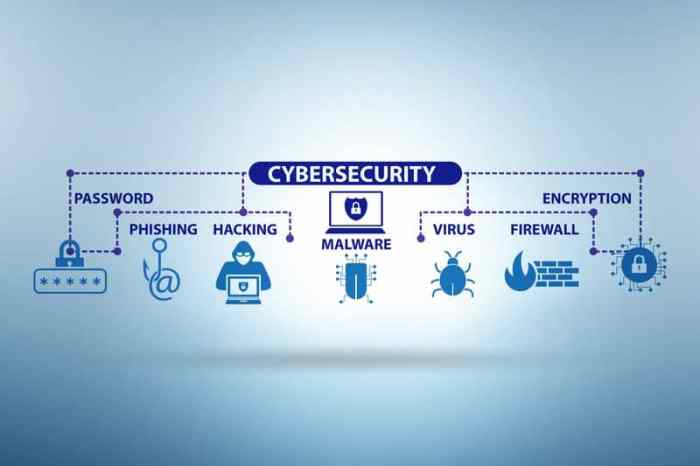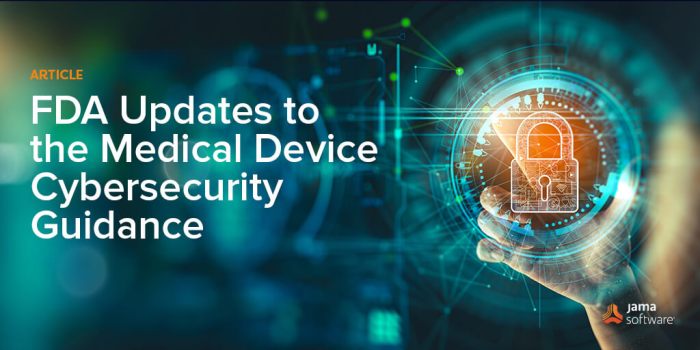
The increasing reliance on interconnected medical devices presents a growing challenge: cybersecurity. From pacemakers to insulin pumps, these devices are vulnerable to attack, potentially jeopardizing patient safety and healthcare operations. Understanding the unique vulnerabilities and developing robust security measures is paramount to ensuring the integrity and reliability of modern medicine.
This exploration delves into the critical aspects of medical device cybersecurity, examining regulatory frameworks, common vulnerabilities, effective security practices, and the crucial role of incident response. We will consider the evolving landscape, encompassing the integration of Internet of Things (IoT) devices and the implications of artificial intelligence (AI) in healthcare.
Introduction to Medical Device Cybersecurity
The medical device industry is increasingly reliant on interconnected systems and software, making cybersecurity a critical concern. Protecting patient data and ensuring the reliable operation of life-saving equipment are paramount, demanding a robust and proactive approach to security. Failure to address cybersecurity risks can have severe and far-reaching consequences.Medical device cybersecurity is the practice of protecting medical devices from unauthorized access, use, disclosure, disruption, modification, or destruction.
It encompasses a wide range of activities, from secure design and development to ongoing monitoring and incident response. The importance of this field cannot be overstated, as vulnerabilities in medical devices can lead to significant risks for patients, healthcare providers, and the healthcare system as a whole.
Potential Consequences of Medical Device Breaches
Breaches in medical device security can result in a range of serious consequences. Compromised devices can lead to inaccurate diagnoses, treatment delays, or even patient harm. Data breaches can expose sensitive patient information, leading to identity theft, financial loss, and reputational damage for healthcare organizations. Furthermore, disruptions to critical medical infrastructure can cause widespread operational challenges and potentially jeopardize public health.
For instance, a ransomware attack on a hospital’s network could cripple its ability to provide essential care, delaying surgeries and impacting patient outcomes. The financial penalties associated with non-compliance with regulations such as HIPAA and GDPR can also be substantial.
Examples of Vulnerabilities in Common Medical Devices
Many common medical devices contain vulnerabilities that can be exploited by malicious actors. For example, insulin pumps, pacemakers, and infusion pumps often rely on wireless communication, making them susceptible to hacking and unauthorized control. Older devices may lack adequate security features, while newer devices may contain unpatched software vulnerabilities. Insufficient authentication mechanisms and weak encryption protocols are also common weaknesses.
A lack of regular software updates and inadequate access controls further exacerbates these vulnerabilities. These vulnerabilities can be exploited to alter device settings, compromise data integrity, or even cause physical harm to patients.
Comparison of Medical Device Cybersecurity Threats
The following table compares different types of medical device cybersecurity threats:
| Threat Type | Description | Impact | Mitigation Strategy |
|---|---|---|---|
| Malware | Malicious software designed to damage, disrupt, or gain unauthorized access to a device. | Data breaches, device malfunction, denial of service. | Regular software updates, strong antivirus software, network segmentation. |
| Ransomware | Malware that encrypts data and demands a ransom for its release. | Data loss, operational disruption, financial loss. | Data backups, strong security controls, incident response plan. |
| Phishing | Attempts to trick users into revealing sensitive information through deceptive emails or websites. | Data breaches, unauthorized access. | Security awareness training, multi-factor authentication, email filtering. |
| Denial-of-Service (DoS) Attacks | Attempts to make a device or network unavailable to legitimate users. | Disruption of services, loss of access to critical systems. | Network security measures, intrusion detection systems, redundancy. |
Incident Response and Recovery

A robust incident response and recovery plan is crucial for mitigating the impact of cybersecurity breaches on medical devices. Such a plan should detail procedures for identifying, containing, eradicating, recovering from, and learning from security incidents. Failure to adequately address these aspects can lead to significant patient safety risks, financial losses, and reputational damage.Effective incident response hinges on proactive planning and regular testing of the plan.
This involves clearly defining roles and responsibilities, establishing communication protocols, and ensuring access to necessary resources. The plan should also incorporate legal and regulatory considerations, as well as strategies for engaging with relevant stakeholders, including patients, regulatory bodies, and law enforcement.
Incident Response Plan Design
A comprehensive incident response plan should Artikel a structured approach to managing cybersecurity incidents. This begins with clear identification and classification of events, followed by containment to prevent further damage. Eradication involves removing the threat and restoring the system to a secure state. Recovery focuses on restoring functionality and operations, while post-incident activity centers on learning from the incident to prevent future occurrences.
Regular testing and updates are essential to maintain the plan’s effectiveness. Consideration should be given to the potential impact on patients, including the need for immediate medical intervention in critical situations. For example, a compromised infusion pump could require immediate intervention and a coordinated response from medical and IT staff.
Forensic Analysis of Compromised Medical Devices
Forensic analysis of compromised medical devices requires specialized expertise and tools. The process involves carefully collecting and preserving evidence to identify the nature, scope, and source of the breach. This includes analyzing device logs, network traffic, and firmware to identify vulnerabilities exploited by the attacker. Chain of custody must be meticulously maintained throughout the process to ensure the admissibility of evidence in legal proceedings.
Advanced techniques, such as memory forensics and malware analysis, may be necessary depending on the complexity of the incident. For instance, analyzing the firmware of an infected insulin pump might reveal the specific malware used and the method of intrusion. The findings of the forensic analysis are crucial in determining the root cause of the breach and implementing effective remediation strategies.
Post-Incident Review and Remediation
Post-incident review is essential for learning from past events and preventing future breaches. This involves a thorough analysis of the incident, including identifying vulnerabilities, weaknesses in security controls, and shortcomings in the incident response plan itself. Remediation involves implementing corrective actions to address the identified vulnerabilities and improve the overall security posture. This may include patching software, upgrading security controls, implementing new security protocols, and providing enhanced training to staff.
A detailed report summarizing the incident, the findings of the analysis, and the implemented remediation measures should be documented and shared with relevant stakeholders. For example, a review of a ransomware attack on a hospital network might reveal a lack of multi-factor authentication, leading to the implementation of this security measure across all devices.
Cybersecurity Incident Response Steps
| Action | Responsible Party |
|---|---|
| Identify and classify the incident | Security Operations Center (SOC) / IT Security Team |
| Contain the incident to prevent further damage | SOC / IT Security Team / Device Manufacturer (if applicable) |
| Eradicate the threat | SOC / IT Security Team / Incident Response Team |
| Recover system functionality | IT Support / System Administrators |
| Conduct post-incident review and remediation | Incident Response Team / IT Security Team / Management |
| Update incident response plan | Incident Response Team / IT Security Team |
Impact on Medical Devices, Research, and Services

Cybersecurity threats pose a significant risk to the functionality, reliability, and overall integrity of the healthcare ecosystem. The impact extends across medical devices, research, and the delivery of medical services, creating vulnerabilities that can compromise patient safety and the advancement of medical knowledge. Understanding these impacts is crucial for developing robust cybersecurity strategies.Cybersecurity threats significantly impact the functionality and reliability of medical devices, research data, and the efficiency of medical services.
Compromised devices can malfunction, leading to inaccurate diagnoses, delayed treatments, and potentially life-threatening consequences. Similarly, breaches in research data can undermine the validity of studies and hinder the development of new treatments, while disruptions to medical services can create significant patient safety risks and operational challenges.
Impact on Medical Device Functionality and Reliability
Malicious actors can exploit vulnerabilities in medical devices to disrupt their operation, alter their settings, or even gain unauthorized control. For example, a compromised insulin pump could deliver incorrect doses of insulin, while a compromised pacemaker could alter heart rate settings. These scenarios highlight the critical need for robust cybersecurity measures to protect the integrity and reliability of these life-saving devices.
The consequences of compromised devices range from minor malfunctions to catastrophic failures with potentially fatal outcomes. This necessitates a multi-faceted approach to device security, including secure design principles, regular software updates, and robust network security protocols.
Impact on Medical Research Data Integrity and Reproducibility
Cybersecurity breaches targeting medical research data can have devastating consequences for the integrity and reproducibility of research findings. Compromised data can be altered, deleted, or even fabricated, leading to inaccurate conclusions and hindering the progress of medical research. This not only wastes valuable resources but also potentially delays or prevents the development of effective treatments and cures. Furthermore, the lack of trust in compromised data can erode public confidence in medical research, impacting funding and collaboration efforts.
Robust data security measures, including encryption, access control, and data backups, are vital to protect the integrity of medical research data.
Impact on the Quality and Efficiency of Medical Services
Cybersecurity breaches can severely disrupt the quality and efficiency of medical services. A ransomware attack on a hospital’s network, for instance, can cripple its ability to access patient records, schedule appointments, or perform critical medical procedures. This can lead to delays in treatment, increased costs, and potentially compromised patient safety. Moreover, breaches can result in the exposure of sensitive patient data, leading to identity theft, financial fraud, and reputational damage for healthcare providers.
Investing in robust cybersecurity infrastructure and training healthcare professionals on cybersecurity best practices are essential to mitigate these risks.
Recommendations for Improving Cybersecurity
The following recommendations aim to improve cybersecurity across medical devices, research, and services:
- Medical Devices: Implement secure design principles from the outset, conduct regular security assessments and penetration testing, and mandate timely software updates and patches.
- Medical Research: Employ robust data encryption and access control mechanisms, implement secure data storage and backup protocols, and establish clear data governance policies.
- Medical Services: Invest in robust network security infrastructure, including firewalls, intrusion detection systems, and antivirus software, and provide comprehensive cybersecurity training for all healthcare personnel.
Securing medical devices is not merely a technological imperative; it’s a moral obligation. By proactively addressing vulnerabilities, implementing stringent security protocols, and fostering collaboration across the healthcare ecosystem, we can mitigate risks and safeguard patient well-being. The future of healthcare hinges on a robust and resilient cybersecurity infrastructure, protecting both patients and the integrity of medical data.
Query Resolution
What is the role of HIPAA in medical device cybersecurity?
HIPAA focuses on the protection of patient health information (PHI). While not directly a medical device security standard, it dictates how PHI handled by medical devices must be protected.
How often should medical devices undergo security updates?
This depends on the device and its manufacturer’s recommendations. Regular updates are crucial to patch vulnerabilities, but the frequency varies. Always follow manufacturer guidelines.
What are the penalties for non-compliance with medical device cybersecurity regulations?
Penalties vary depending on the regulatory body and the severity of the violation. They can include fines, recalls, legal action, and reputational damage.
Can a cybersecurity breach lead to a recall of a medical device?
Yes, if a significant vulnerability is discovered that poses a risk to patient safety, a recall may be mandated by regulatory bodies.

